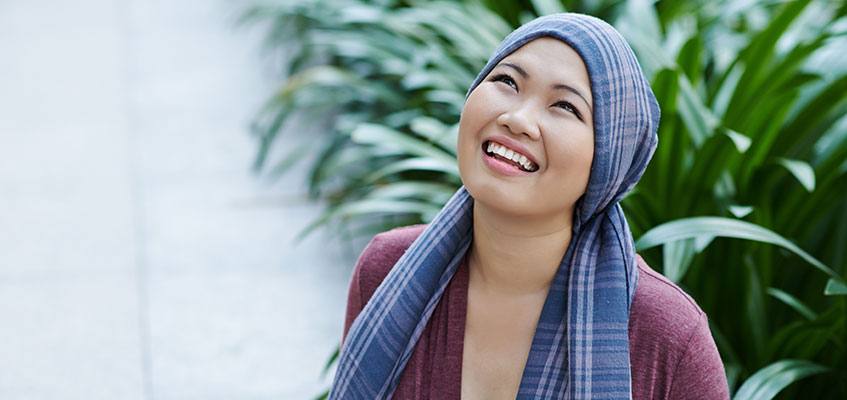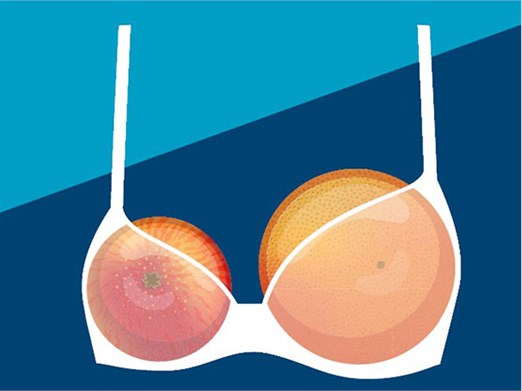Losing it
What can you do when chemotherapy causes hair loss?

Losing your hair is a very visible sign that you have had cancer and its impact on your appearance can be devastating. In fact women often say that, on diagnosis, the thought of losing their hair was far more worrying than the loss of their breast and many are prepared to go to great lengths to preserve it. We talk to readers about how they struggled to keep their hair on and look at the alternatives for those who can’t.
For most women diagnosed with breast cancer, chemotherapy will form part of their treatment. Usually administered intravenously, chemotherapy drugs destroy cancer cells by attacking them and disrupting their growth. Unfortunately the drugs can also affect healthy cells, including those of the hair follicles. Not all chemotherapy drugs make your hair fall out; however, some drugs cause partial or total loss on the scalp and some also affect body hair such as eyebrows, eyelashes, leg, underarm and pubic hair. While the latter three are probably welcome reductions to most women’s stock of productive hair follicles, we live in a society where appearances matter very much, and a healthy head of hair, whatever your age, is an important part of your image – affecting not just the way others see you, but also the way you see and feel about yourself.
We’ve all had bad hair days. Most of us can recall the total embarrassment caused by a scissor-happy hairdresser taking off that bit too much, a new colour that seemed like a good idea at the time, or an ill-advised perm that would put a poodle to shame. Such beauty bungles make you want to wear a sign saying: “I don’t usually look like this!” So while it’s a look that can just about be pulled off by the young and pretty (remember singer Sinead O’Connor and presenter Gail Porter?) the thought of walking around with just a few faint wisps of hair, or without any hair at all, is horrific to most women. “It’s like wearing a sign saying ‘I’ve got cancer’,” says Debbie Francis, who lost most of her hair during her breast cancer treatment in 2009.
If your treatment includes epirubicin, Docetaxel (taxotere), Taxol (paclitaxel) or cyclophosphamide, amongst others, you are probably facing a certain amount of hair loss. Your healthcare team will tell you what to expect – sometimes the effect is just a slight thinning of your hair, but some drugs cause it to fall out very rapidly after the first treatment, which can be particularly distressing as it gives you no time at all to adjust to your new appearance.
A cool option if you're losing your hair
So what options do you have if you’re likely to lose some or all of your hair? Many women decide to try and prevent or minimise hair loss, and that means scalp cooling, or the ‘cold cap’. Cooling the scalp causes the blood capillaries that feed the scalp to constrict, which minimises blood flow, thus restricting the amount of chemotherapy drug that can reach the scalp – and the hair follicles – while you are receiving your treatment.While some hospitals don’t have the facility to offer scalp cooling, most do these days, and you are quite within your rights to insist on it as part of your treatment. There are two main types – one uses a hat known as a cold cap, which is filled with gel that can be chilled, while the other is based on a refrigerated cooling system that pumps liquid coolant into a cap while you wear it. If you’re considering one, it’s worth talking to other women who have tried it, although it’s important to bear in mind that everyone’s experience will be slightly different. After all, for some women a bikini wax is nothing, while for others it’s agony! Gel-filled cold caps can be applied easily and are kept in place by Velcro. The cap can be very uncomfortable and heavy, as well as being extremely cold, and may give you a headache. It also needs to be changed every 20–40 minutes to keep your scalp cool. Caps attached to the cooling system generally feel lighter but can be restrictive, as you will need to sit by the machine while the cap is in place. However, it can be disconnected for short periods if necessary, for example if you need to pop to the loo.
Both methods need to be worn for some time before and after the chemotherapy drugs are given, which means that each chemo session will last longer and you may have the cap on for a few hours each time. This is a tough call if, like so many of us, you hate being cold, but you will be offered blankets and hot drinks. Many women say they took some music, a book or a game to help pass the time and take their minds off the big freeze.
Does the cooling cap work?
The big question is: does it do the job? To which we would probably answer: that depends on your perspective, your attitude and your expectations. When we asked readers to tell us whether the cold cap worked for them, we expected a range of responses from “Absolutely!” to “Definitely not!” In fact, everyone who wrote to us – and there were lots of letters and emails on this particular topic – said that it had indeed worked for them. What’s important here is how these women defined success. Some lost hardly any of their hair and were able to carry on as normal. Several found their hair became much finer but they were OK with that, while others said they preserved just enough hair to have something showing around the edges of a headscarf which, for them, still meant a positive result.
Some women prefer a wig for hair loss
Whether the thought of the cold cap is unbearable or you find it doesn’t work for you, there are alternatives to disguise hair loss, such as scarves and hats and, of course, wigs. It’s probably a good idea to get yourself a wig at the start of your chemo, even if you do plan to try scalp cooling. When you are coping with the rigors of treatment, knowing that you can reach out for something that will instantly make you look like ‘you’ again is a comfort, and you might even come to love the ease and flexibility that wigs can offer.
Donna Cunningham invested in a lovely real hair wig that looked similar to her own long, thick hair before her treatment started. “My hair did start falling out about ten days after my first session,” she says, “so I decided to take matters into my own hands.” While embracing the use of her wig whenever she wanted to look like the Donna of old, she and her boyfriend also decided to have some fun styling her own hair in ways that Donna would never have considered before. “Instead of just going for the whole chop in one go, I thought it was a perfect opportunity to try out different styles. Over a series of weeks I went from long to mid-length hair, then with a fringe to a short cropped fringe, then a bob, right the way through to a Mohican and Mohawk look. Throughout the process we took lots of pictures and it really made me feel better.” Donna actually enjoyed the experience of cutting her own hair and trying different styles: “I still have all the pictures and, now my treatment has finished and my hair is just about starting to grow back, it’s nice to look at them and visualise what styles I might have in the next 12 months or so. I found it a positive experience – it took away all my fear and dread of losing my hair. Perhaps other women in the same situation could think about taking this route instead of just shaving it all off in one go.”
Comfortable headscarves to go
Pre-tied head scarves are an elegant and easy solution for women on the go.
Fit is important if you are hiding hair loss – particularly if there is little or no hair to clip the scarf to for security. Look for chemo scarves with additional stretch, because they will stay in place. Many times you can wear them arranged in a variety of ways, and together with hats and caps, you've got a comprehensive wardrobe of options that are great for any day or occasion.
After chemotherapy the choice is yours
Even though it can be devastating (after all, stylists refer to hair as ‘the outfit you never take off’, which is all very well until chemo does it for you!), hair loss is only temporary and many women have told us that their hair got a new lease of life post-chemo, sometimes coming back thicker and better than before. So whether you decide to brave the cold cap or adapt your look with headwear or wigs, there are some creative ways of getting through this uncomfortable period and, who knows, you might even find a new look that you love!







